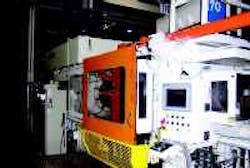Controller retrofit boosts mold-machine productivity
JVH Engineering retrofitted a major automotive supplier's injectionmolding machine and added a closed-loop controller developed by Rockwell Automation working with Bosch Rexroth.
Grandville, Mich.-based JVH Engineering, a company that retrofits injectionmolding machines, was met with the challenge of improving a major automotive supplier's 1986 700-ton injectionmolding machine with a high scrap rate and little process control. As a result of the retrofit, scrap rates dropped 90%, cycle times shortened by two sec, and mold-filling accuracy improved 89.8%.
For this project, JVH went with a new closed-loop controller developed by Rockwell Automation in conjunction with Bosch Rexroth. An Allen-Bradley SLC 5/05 processor communicates to a Bosch Rexroth DPQ-2 digital injection controller and a Bosch Rexroth closed-loop controller (DPC) via DeviceNet. The package also includes a 12-in. Allen-Bradley VersaView 6182 Windows CE industrial computer running Rockwell software RSView machine-edition-HMI software.
"The DeviceNet network lets the automotive supplier communicate with the Bosch Rexroth closed-loop controllers and download set points for process control," explains Rodney Rotman, vice president of JVH. "The SLC triggers the different process parts, such as initiating the machine-clamp-close process. Once a cycle is complete, the Bosch Rexroth cards provide data for determining how well the machine performed."
JVH worked with the supplier on the operator interface in RSView machine edition using RSView Studio, a PC-based development tool that simplifies application design and reduces development time. Engineers configured the machine's injection-process screen, as well as its maintenance and quality-control screens. For example, with its quality-control function, the machine immediately discerns if a finished part is good or bad and tells the robot to discard it or place it on the finished-parts conveyor belt.
The automotive supplier demanded a Rockwell Automation solution because of the easy-to-integrate Allen-Bradley features and because its maintenance personnel were experienced with the control platform. In its original analysis, the supplier estimated that the old machine would run 2-sec slower than a new one, but cost savings from retrofitting would make up for the delay in cycle time. However, the retrofit machine met the new-machine cycle times, making the new control system 5% more efficient than anticipated for an increase of five produced parts/hr.
Rockwell Automation
Milwaukee
rockwellautomation.com
